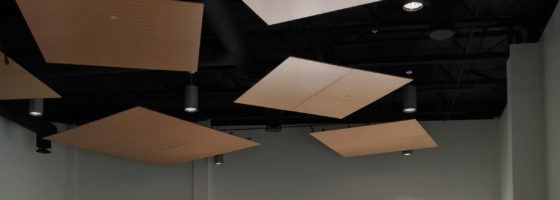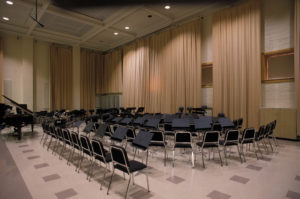Acoustic Design in K-12 Music Classrooms
Russ Cooper | May 14, 2018

If there’s one type of classroom where acoustic design should be a top priority, it’s undeniably the music classroom. Bringing an acoustic consultant on board at the beginning of the project allows the architect to receive valuable insight early on in the process. A well-designed space for student musicians begins with determining what the room will be used for — such as a space for rehearsal, music instruction, theory, history or all of the above. The program leads the acoustic design. Once that is established, the room must be located in the appropriate place within the building, close to other music and performing arts spaces.
The classroom acoustics standard, ANSI S12.60, is used to design the room acoustics. This standard provides the proper reverberation time, background sound levels and sound transmission requirements for walls and floor-ceiling assemblies in order to achieve a quality learning environment free from major distraction. The criteria for music classrooms are more stringent than in other learning spaces because music classrooms have higher sound levels and larger volumes. For example, standard classrooms have a sound transmission requirement of 50 decibels, while an adjacent music classroom has a requirement of 60 decibels.
The acoustic consultant will examine the adjacent spaces and recommend appropriate wall and floor-ceiling assemblies to ensure the required sound isolation is achieved. Music classrooms also need to be isolated from external sound sources, such as traffic noise. This includes a review of the weak links in the facade, such as windows and doors.
The ANSI standard provides the criteria that must be met for background sound. Mechanical equipment noise and vibration (HVAC) sources should be examined not only for the noise they generate but also for how noise is transmitted down paths leading to the classroom. A room that is too noisy will be distracting and reduce the ability of students to understand the teacher, hear themselves and hear other students playing in the room.
The interior geometry and volume of the space, as well as the finishes, are important to room acoustics. When a space has too long of a reverberation time — also known as being “too live” — the ability to understand speech is reduced. The ANSI standard provides the criteria that must be met for reverberation time in terms of proper listening conditions in various size classrooms. Achieving this correct reverberation time is critical to the success of the room.
Since finishes reflect sound in different ways, design choices for floors, walls, ceilings and furniture can have a significant effect on sound quality. Absorptive panels are used to achieve the reverberation time criteria, but their use alone will not provide satisfactory acoustic conditions. The standard does not take into consideration the orientation of reflective and diffusive surfaces that spread sound evenly in the room to promote hearing. This often takes the form of convex wall and ceiling panels or “clouds” hung within the space. The acoustic consultant provides crucial insight for this requirement.
The program for each classroom must also be considered. If the room needs to work for a variety of purposes, adjustable acoustics can help. For example, heavy velour drapes can be drawn throughout the space or tucked into a pocket to help control the reservation time of a particular type of program.

A well-designed music classroom needs a high-quality audio and video system to properly teach the pedagogy. This typically includes a video projector and projection screen with high-quality speakers for music reproduction. The system should include playback equipment according to the user’s desires. A classroom might also include an audio and video recording system for archival or instant playback. Music teachers want to be able to hit a button, record a piece of music, hit stop and then play it back.
Ideal acoustic design in K-12 music classrooms is achieved through careful consideration of all the elements that make up the space — which is why acoustic and audio/video consultants should be consulted early in the design or renovation process. By adhering to the ANSI standard on classroom acoustics and using good acoustic design principals, such as examining a space’s programming, location, proximity to noise sources and need for acoustic treatments, acoustic consultants can produce highly-functioning music classrooms for the design team.

Comments